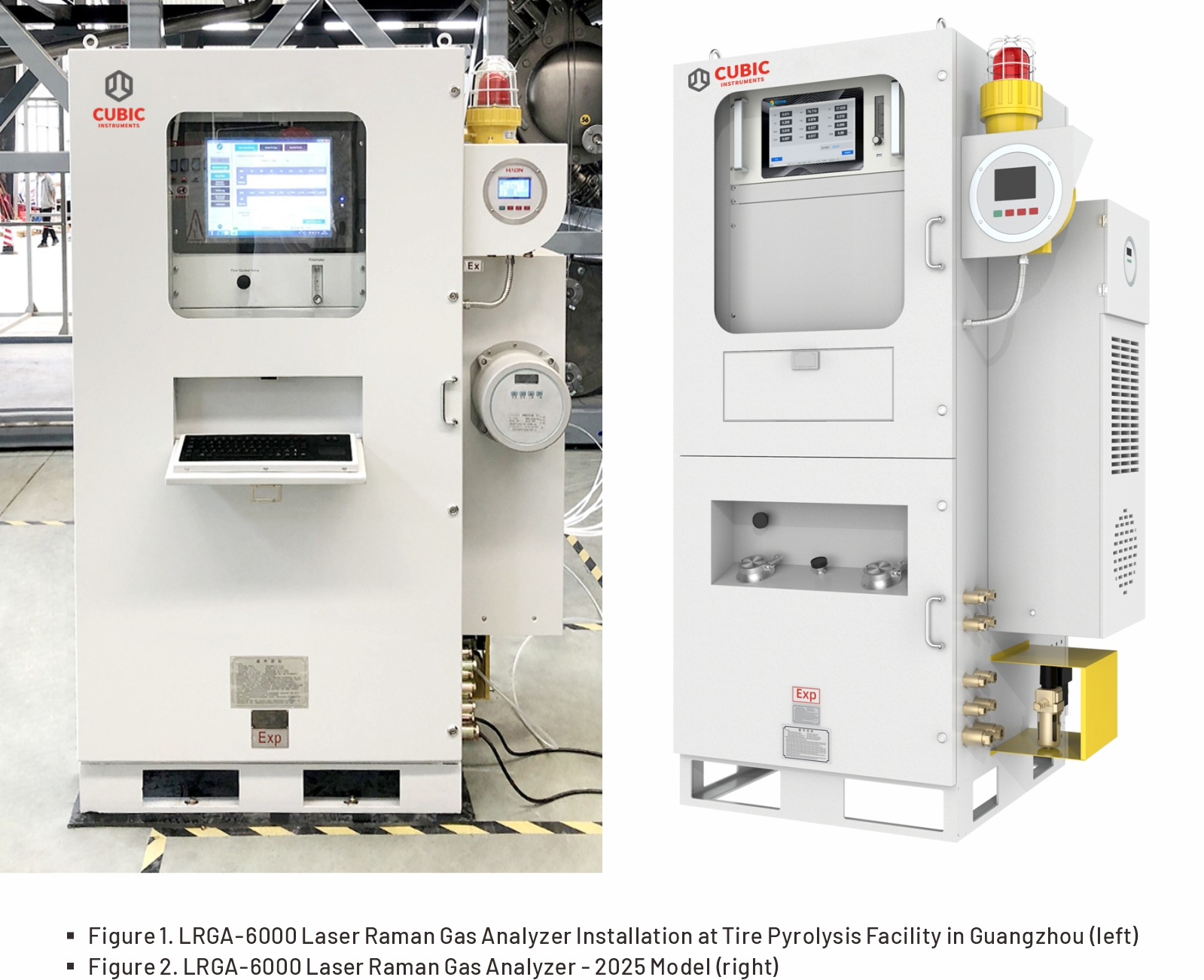Background: Turning Waste Tires into Valuable Resources
An environmental company in Guangzhou, China, operates a government-supported waste tire recycling facility with mainly output of carbon black base on its own waste to energy (WTE) technology. The project aims to achieve both environmental protection and economic benefits through the recovery of valuable products including carbon black, fuel oil, and pyrolysis gas from waste tires. The recovered materials serve as important feedstocks for various industries, including rubber manufacturing, fuel production, and chemical synthesis.
The company reached out to Cubic Instruments seeking high-accuracy and reliable gas analysis equipment that could provide continuous monitoring of multiple gas components during the pyrolysis process for the purpose of enhancing production efficiency and process safety.
Challenge: Monitoring Complex Gas Parameters Across Multiple Production Stages
The production facility operates a production line with eight continuous gasification furnaces, consisting of six high-temperature pyrolysis furnaces and two purification furnaces. The rubber pyrolysis process occurs in an anaerobic environment under precisely maintained micro-negative pressure at temperatures between 200-450ºC, requiring stringent process control to maintain optimal reaction conditions.
• Initial Stage: Monitoring CH4 levels to ensure proper reaction initiation and establish optimal thermal decomposition conditions. Accurate methane measurement serves as a critical indicator of reaction progression and efficiency.
• Main Reaction Stage: Controlling oxygen levels to prevent uncontrolled combustion or explosion risks while maintaining the ideal anaerobic environment necessary for high-quality product formation. The amounts of oxygen can significantly impact both process safety and product quality.
• Final Stage: Analyzing heavy hydrocarbons (C5+) to optimize carbon black production through feedstock control and reaction parameter adjustment. The composition of these hydrocarbons directly influences the quality and properties of the carbon black product.
Thus, the company required a comprehensive monitoring solution that could provide accurate, real-time measurements of multiple gas components simultaneously at multiple critical points throughout the production process, including reaction inlets, furnace interiors, and carbon black outlets, to ensure both production efficiency and process safety.
Solution: Advanced Laser Raman Technology for Comprehensive Analysis
Cubic Instruments, a leading manufacturer of superior gas analyzers, has leveraged Cubic mature technology platform of Laser Raman spectroscopy technology, and develop the LRGA-6000, an advanced analytical system delivering high-precision gas measurement in various complex and hazardous industrial conditions.
Based on the principle of Laser Raman Scattering, LRGA-6000 excites, collects, processes, and identifies the characteristic Raman Scattering spectra of measured gases to achieve both qualitative and quantitative analysis with exceptional precision. The system enables simultaneous monitoring of over 13 different gas components, including CO, CO2, CH4, C2H2, C2H4, C2H5, C3H8, H2O, NH3, iC4, nC4, and crucial homonuclear diatomic gases such as H2, N2, and O2, which are typically challenging to detect with conventional GC analytical methods.
Through a flexible multi-channel sampling design, a single LRGA-6000 unit can realize multiple critical points monitoring across the entire gasification process. With comprehensive coverage, the system allows monitoring of CH4 at reaction inlets, O2 in furnace interiors, and C5+ at carbon black outlets. The comprehensive analytical capability of LRGA-6000 eliminates the need for multiple specialized instruments, significantly reducing system complexity, simplifying operation process, and enhancing both data consistency and maintenance efficiency.
Key Advantages of LRGA-6000
The LRGA-6000 system delivers high-accuracy measurement results with a broad detection range from 0.1% to 100%, providing precise gas concentration measurements essential for process optimization. Its fast response time within seconds enables real-time analysis, allowing immediate process control adjustments and safety interventions to maintain optimal reaction conditions throughout the production cycle.
In addition, the system ensures continuous monitoring through non-destructive measurement, maintaining uninterrupted production operations. The built-in real-time gas quality analysis allows for the calculation of key indexes including calorific value and Wobbe index, which aids in process optimization and ensures consistent product quality.
Beyond its performance benefits, LRGA-6000 significantly reduces maintenance costs. It does not require consumables such as valves, ovens, columns, or carrier gases in gas chromatography (GC) systems, which minimizes maintenance requirements, reduces downtime, and lowers operational costs, making it a cost-effective and efficient solution for industrial gas analysis.
Results and Impact: Optimized Production with Enhanced Safety and Environmental Benefits
Following the successful implementation of LRGA-6000 in replacement of the previously utilized GC system, the environmental company has achieved precise control over its pyrolysis process while maintaining strict safety standards. The LRGA-6000 system's comprehensive monitoring capabilities have optimized production efficiency and resource utilization, ensured consistent product quality and process stability, and reduced operational costs through minimized maintenance requirements.
By integrating Cubic Instruments’ advanced gas analytical system, the facility has reinforced its capability in sustainable waste tire recycling, processing tens of thousands of tons of waste tires annually while maximizing both environmental and economic benefits.



 EMAIL
EMAIL

